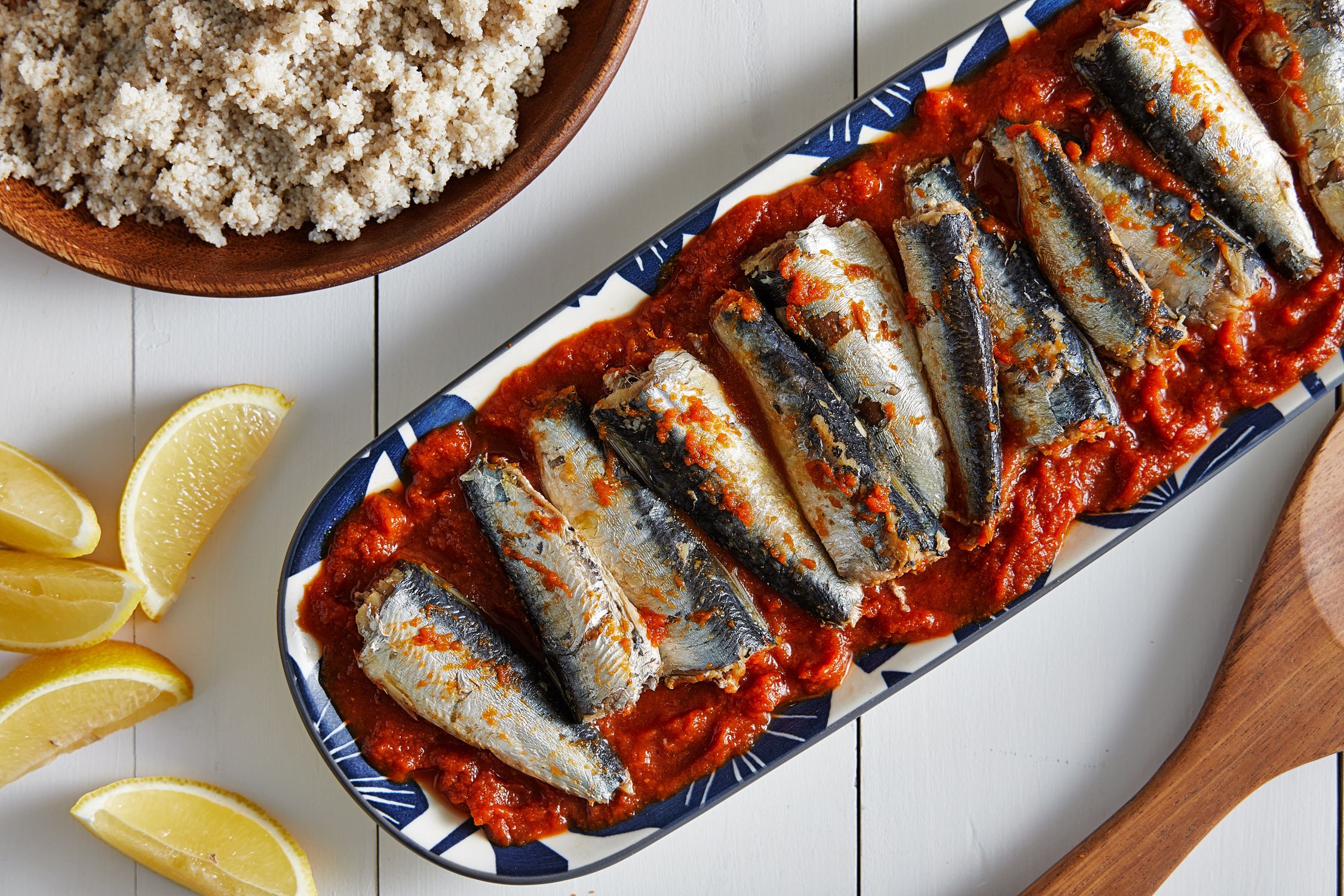In the vast ocean of seafood options, sardines emerge as tiny titans packed with a plethora of health benefits that often go unnoticed. These small, silvery fish may not boast the glamour of their larger counterparts like tuna and swordfish, but when it comes to nutrition, they stand head and shoulders above the competition.
Nutritional Profile
Per 3.5-ounce (100-gram) serving of sardines, you can revel in an impressive nutritional profile that makes these small fish a dietary powerhouse.
Sardines provide approximately 25 grams of protein per serving, making them a rich source of this essential macronutrient. Protein is vital for various bodily functions, including muscle repair, immune support, and enzyme production. With sardines, you can easily incorporate a significant portion of your daily protein needs into a single serving.
The omega-3 fatty acid content in sardines is equally noteworthy. A 3.5-ounce serving typically contains around 1,480 milligrams of eicosapentaenoic acid (EPA) and 980 milligrams of docosahexaenoic acid (DHA). These omega-3s are pivotal for heart health, reducing inflammation, and supporting cognitive function. Sardines, with their abundant omega-3 content, outshine many other seafood options, offering a concentrated dose of these beneficial fats.
Vitamin D is another nutrient where sardines excel. A serving provides approximately 272 international units (IU) of vitamin D. This vitamin plays a crucial role in calcium absorption and bone health, making sardines an excellent choice for those looking to bolster their skeletal strength.
Incorporating a serving of sardines into your regular meals not only satiates your protein requirements but also delivers a potent combination of omega-3 fatty acids and vitamin D, contributing significantly to your overall health and well-being.
So, How do Sardines Compare?
Now, let's dive into the comparison with heavy metal fish like tuna and swordfish. While these larger fish are also excellent sources of protein and omega-3 fatty acids, they come with a hidden danger – heavy metal contamination. Tuna, in particular, has gained notoriety for accumulating high levels of mercury, which can have detrimental effects on human health, especially for pregnant women and children.
Heavy metals like mercury, arsenic, and cadmium can accumulate in the flesh of certain fish, posing serious health risks when consumed in large quantities. Swordfish, due to its predatory nature and long lifespan, tends to accumulate higher levels of mercury, making it less suitable for frequent consumption. Sardines, on the other hand, are lower on the food chain, feeding primarily on plankton, and thus, they accumulate fewer heavy metals.
While both sardines and heavy metal fish contain omega-3 fatty acids, the ratio of omega-3s to mercury in sardines makes them a safer and more beneficial choice. The benefits of omega-3s extend beyond cardiovascular health; they play a pivotal role in reducing inflammation, improving cognitive function, and supporting joint health. With sardines, you can enjoy these advantages without the looming threat of heavy metal toxicity.
Sardines aren't just a one-trick pony; they also contribute significantly to bone health. Packed with calcium and vitamin D, these small fish promote bone density and help prevent osteoporosis. The combination of these nutrients makes sardines an excellent dietary choice for individuals looking to fortify their skeletal structure and ward off bone-related ailments.
In addition to being a nutritional powerhouse, sardines are also an eco-friendly choice. They reproduce quickly and have a short lifespan, meaning their populations can withstand sustainable fishing practices. Choosing sardines over heavy metal fish contributes to the preservation of marine ecosystems and helps maintain a healthy balance in ocean biodiversity.
Incorporating Sardines Into Your Diet
Now that the spotlight is on sardines, the question is: how can you make them a delicious and regular part of your diet? Sardines are incredibly versatile; you can enjoy them grilled, smoked, canned, or even fresh. Their distinct flavor pairs well with various dishes, from salads to pasta, adding a nutritional boost to your meals.
Conclusion
In the world of seafood, size doesn't always matter. Sardines, with their small stature, manage to pack a punch when it comes to health benefits. Their omega-3-rich, heavy metal-low profile makes them a superior choice compared to heavy metal fish like tuna and swordfish. So, why not add these tiny titans to your plate and savor the delicious, nutritious benefits they bring? Your taste buds and your health will thank you.
Harvest Walnut Salad Recipe
This Harvest Walnut Salad is a symphony of fall flavors and textures. The sweetness of the apple and butternut squash, the creaminess of the goat cheese, the crunch of toasted walnuts, and the tangy notes from the maple Dijon vinaigrette create a perfectly balanced dish. Packed with protein, vitamins, and healthy fats, this salad is not only delicious but also a nutritious addition to your menu. Enjoy the delightful combination of seasonal ingredients in this satisfying and wholesome salad!
Ingredients
For the Salad:
- 2 cups cooked and shredded chicken breast
- 3 cups mixed salad greens (arugula, spinach, and romaine)
- 1 cup butternut squash, cubed and roasted
- 1 large apple, thinly sliced (use a crisp variety like Honeycrisp or Fuji)
- 1/2 cup crumbled goat cheese
- 1/2 cup walnut halves, toasted
- 1/4 cup dried cranberries
For the Maple Dijon Vinaigrette:
- 1/4 cup extra-virgin olive oil
- 1/4 cup apple cider vinegar
- 1 tablespoon pure maple syrup
- 1 tablespoon Dijon mustard
- Salt and pepper to taste
Instructions:
1. In a large salad bowl, combine the mixed greens, shredded chicken, roasted butternut squash cubes, apple slices, crumbled goat cheese, toasted walnuts, and dried cranberries.
2. In a small bowl, whisk together the olive oil, apple cider vinegar, maple syrup, Dijon mustard, salt, and pepper until well combined.
3. Drizzle the maple Dijon vinaigrette over the salad and toss gently to coat all the ingredients evenly.
4. Transfer the salad to individual plates or a large serving platter.
5. Garnish the salad with additional crumbled goat cheese and a few more toasted walnuts for added texture.
6. Serve immediately and enjoy the delightful combination of flavors and textures in every bite.
Optional Enhancements:
- For a heartier meal, add quinoa or farro to the salad.
- Incorporate a handful of baby kale or chopped fresh herbs for extra freshness.
Conclusion
Detoxing after the holidays is not about punishment; it's a gesture of self-care and a commitment to rejuvenating your body. The Detoxifying Green Goddess Soup is just one example of the many delightful and health-boosting recipes you can explore. As you embark on this journey to a healthier you, remember that small, sustainable changes make a significant impact, and the path to well-being is paved with delicious and nutritious choices. Cheers to a fresh start and a revitalized, nourished body!
Questions? Call PIH at 609.512.1468 for more information.




